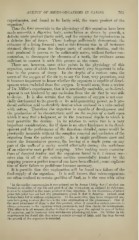Page 751 - My FlipBook
P. 751
AGENCY OF MICRO-ORGANISMS IN CARIES. 761
experimenter, and found to be lactic acid, the waste product of the
organism.^
Thus the four essentials in the physiology of this organism have been
made out—viz. a digestive body, assimilation as shown by growth, a
definite waste product (lactic acid), and the capacity for reproduction in
a definite line of forms. These findings sufficiently demonstrate the
existence of a living ferment ; and as this ferment was in all instances
obtained directly from the deeper parts of carious dentine, and the
acid produced is proven to be sufficiently active, without fm'ther con-
centration, to decompose the elements of a tooth, the evidence seems
sufficient to connect it with this process as the cause.
There are, however, some other points in the physiology of this
organism, some of which have been determined; very important in rela-
tion to the process of decay. In the depths of a carious mass the
access of the oxygen of the air is, to say the least, very precarious, and
it becomes important to know whether the organism is capable of devel-
opment when excluded from free oxygen. It would seem, from a review
of Dr. Miller's experiments, that it is practically anaerobic, as its devel-
opment is not hindered by any exclusion from the air that he was able
to devise. It is also certain that the presence of oxygen is not espe-
cially detrimental to its growth or its acid-generating power, as it pro-
duced sufficient acid to decalcify dentine when enclosed in a tube corked
with cotton. Therefore the organism is capable of development and
the production of its characteristic acid on tJie surface of a tooth upon
which it may find a lodgment, or in the innermost depths to which it
may penetrate the dentine. In its relation to caries this is a very
important consideration ; for if there is no other hindrance to its devel-
opment and the performance of the functions detailed, caries would be
practically incurable without the complete removal and exclusion of the
organism from the carious cavity. As it might proliferate anew and
renew the fermentative process, the leaving of a single germ on any
part of tlie walls of a cavity would effectually destroy the usefulness
of an otherwise most perfect stopping. After making many examina-
tions of decayed dentine and the organisms found in it, I cannot con-
ceive that in all of the carious cavities successfully treated by the
stopping process a perfect removal can have been effected ; some explana-
tion of their failure to proliferate becomes necessary.
It is possible that this explanation will be found in a failure of the
food-supply of the organism. It is well known that micro-organisms
are often confined to certain qualities of food, as is the case with other
^ In the earlier controversies it was pointed out by Justus Liebia; that if alc
it must be regarded as the waste product of that organism. In the discussions of recent
years this point has not had the prominence given it that it deserves. Indeed, most
writers have left it without explanation. At the same time, they have recognized cer-
tain facts going to show that tliis is the true explanation of the phenomena. One of
the Tnost prominent of these is that this product, when it exceeds a certain amount, is
always poisonous to the organism wliich produces it, and thus checks its development.
This effect is in ail respects similar to that of urea upon the animal in case of failure
of excretion, and in harmony with well-known pliysiological laws. Dr. Miller in his
experiments has found also that when a certain amount of lactic acid has been formed
the growth of the organism is retarded.


